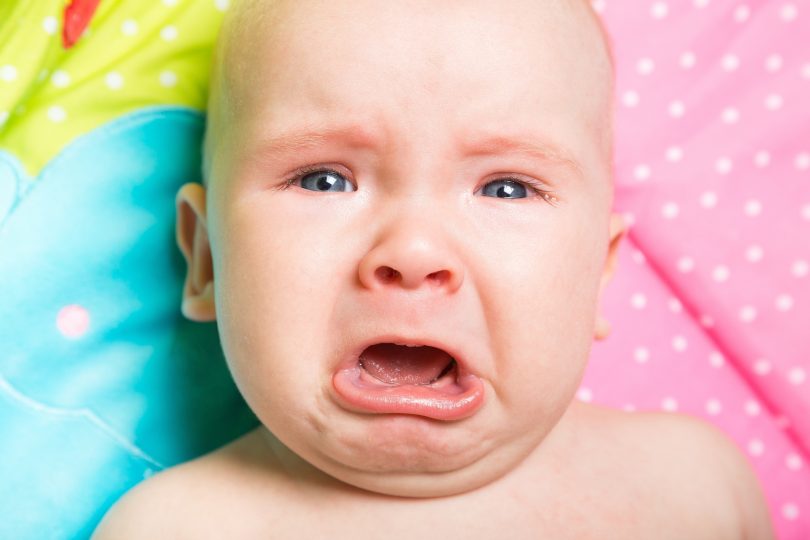We all expect a baby to cry.
But none of us expect our baby to cry for hours at a time—nonstop—for days and days on end.
As a new parent, it wears you down, breaks you, until you’re in tears yourself, wondering, “What am I doing wrong?”
The answer? Probably nothing. If your baby is otherwise healthy, he or she most likely has colic.
Off the Charts Crying
Here’s the definition: Colic typically starts around 3 weeks and can last until a baby is a few months old.
“Colic involves a healthy, growing, thriving baby who cries for over three hours at a time, at least three days a week,” said Dr. Clay Stallworth, a pediatrician at Augusta University West Wheeler. “This is a baby with no apparent reason for crying, no wet or dirty diaper, who isn’t too hot or too cold, isn’t injured, has a normal temperature and isn’t hungry. This is also a baby whom you pick up and who still won’t stop crying.”
Nobody knows why some kids are more colicky than others. But we do know this: “The crying is not harming the baby, even though it might feel like it lasts forever to the parent when you’re in the middle of it,” said Stallworth. “But it really won’t last forever.”
In most cases, colic will be over by the time your baby is four months old. And in 90 percent of colic cases, the unending crying stops when your baby is about two and a half months old.
Comfort Measures for Colic
But as a parent, it’s tough to let your child just cry. You’ve got to do something.
Even though there’s no hard-and-fast reason for why colic happens, there are a lot of theories. Most people blame gas. But, “what I tell people is that, often, babies are not fussy because they’re gassy; they’re gassy because they’re fussy,” said Stallworth.
In other words, colicky babies who cry and cry also swallow air, which leads to gas in their tummies.
Still, helping your baby get rid of gas may make him or her more comfortable. You can try Mylicon® or the generic simethicone, available over the counter. “Bicycling” your child’s legs and some gentle tummy rubs can help too.
Here are a few other suggested remedies:
- Once breastfeeding is well established, offer your child a pacifier.
- Take your child for a walk in the stroller or for a ride in the car (always making sure to use a proper car seat and that your child is strapped inappropriately).
- Swaddle your baby, but always make sure you swaddle the legs with the hips bent up and out and knees up. “Don’t swaddle your baby with the legs straight down since that could lead to hip dysplasia,” said Stallworth, which is a condition where the soft cartilage of the hip socket is damaged, or even dislocated.
- Try white noise, but keep the volume low and soothing.
What’s not safe to try? Gripe water, herbal remedies or essential oils aren’t regulated by the U.S. Food and Drug Administration, said Stallworth, which means you don’t know what exactly the ingredients are. Some could even have the potential to be toxic, so pediatricians don’t recommend them.
Probiotics and fiber supplements are new colic strategies that parents may have read about, but these aren’t recommended either and could again be potentially harmful. Chiropracty is also not recommended for babies or toddlers.
The Diet Question
Besides gas, parents often wonder if the food their child is eating—breastmilk or formula—may not be agreeing with them and causing colic.
Most of the time, a protein intolerance will have signs such as bloody stool or a bad rash, said Stallworth. Very rarely will crying be the only symptom.
But, it’s possible. For babies who are formula fed, parents can try a hypoallergenic formula to see if that makes a difference.
If your child is breastfeeding, eliminating dairy from the mother’s diet has been shown to help sometimes. “There’s all kinds of helpful advice online to avoid this food or that,” said Stallworth. “But the only thing with even marginal evidence that it works is dairy elimination.”
Taking Care of You
During these few tough months, it’s also important to take care of you, said Stallworth.
“Talk to someone who’s had the experience,” he said. “Many people have had a colicky kid, so just go on Facebook or ask your friends. Talking or venting with other parents can help a lot.”
Colic can especially be hard on single moms or dads. Whatever your situation, arrange to get a break every once in a while from a friend, relative or babysitter. Take the time to relax, and clear your head.
It’s a sobering thought, but you never want the stress to get so bad that you do something to your child. “Having support and taking a break is really crucial,” said Stallworth.
What If It’s Not Colic?
It’s also important to point out that if your child is crying really hard for a really long time and has other symptoms, you need to see a physician right away. For example:
- If your child is not eating and is losing weight
- If your child has forceful vomiting
- If your child has a fever
- If you see any abnormal swelling
- If you think your baby has been hurt
Some things are harder to notice. Stallworth always checks for three things if a parent brings a child in for uncontrollable crying:
- A scratched cornea.
- A hair tourniquet, which is when a single hair gets wrapped around a child’s toe or finger, cutting off the circulation
- A hernia, which can sometimes happen for no reason, and is usually visible as a lump in the scrotum or labia
“Just remember that your pediatrician is here to check out your child anytime,” said Stallworth. “If you need reassurance, if you need help, contact your child’s doctor. And if it is colic, make use of whatever relief you can get to clear your head, take a deep breath and hold onto your sanity. And remember, it is not forever.”




